As a tactical RPG game, Reverse 1999 carries a lot of challenges that can only be handled with the right teams. A good team needs to be created with the top characters, but not all these characters are suitable for making a high impact. So, here is a Reverse 1999 team building guide with tips, and we will also recommend the best team compositions to rely on for better gameplay success.
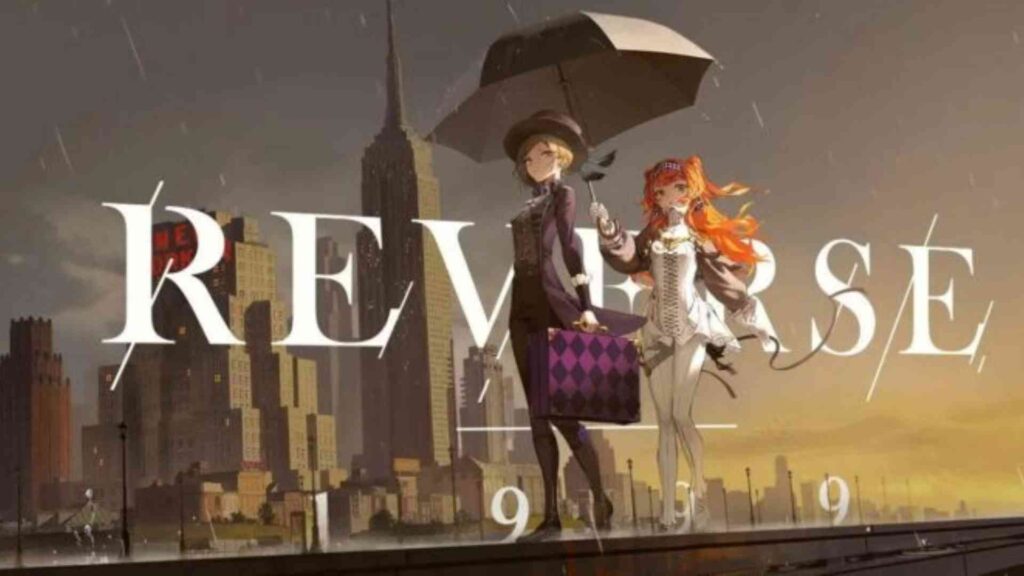
Don’t forget to top up Reverse 1999 gameplay with the best live top-up application from Enjoygm. The most affordable coin packs are available in the safest environment for transactions. The safest and most reliable way to power up your gameplay is with Enjoygm.
Core Mechanics That Shape Team Building
When you put together a team with Reverse: 1999 tier list of characters, there are a few core mechanics you need to understand.
Combat runs on a card-based system. Every Arcanist provides incantation cards, which act as skills. You can merge these cards to raise their star level, making them more powerful. Your team has three active slots and one substitute, but the sub only comes into play if someone is knocked out. Each round gives you 7 Action Points (AP), and every move costs AP. That includes using skills, merging cards, or shifting them around. Because of this, teams that can generate extra AP or lower AP costs will last much longer in drawn-out battles.
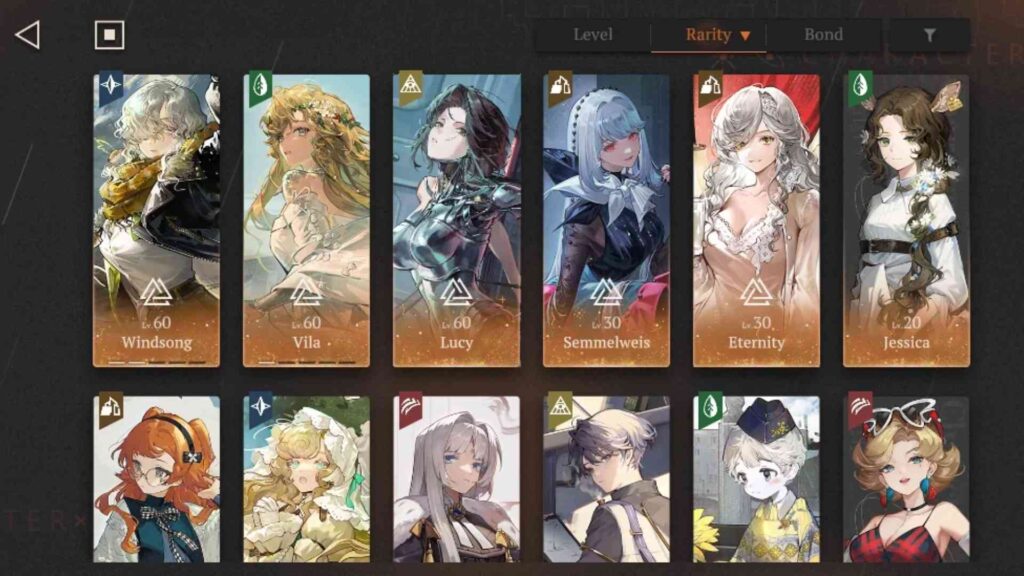
Affinities (Afflatus) work like type advantages. Here is the cycle: Mineral beats Beast, Beast beats Plant, Plant beats Star, and Star beats Mineral. Spirit and Intellect counter each other directly. If you bring the recommended affinity for a stage, you gain a 30% damage boost and extra resistance, so it pays to match your lineup to the challenge.
There are also three damage types to keep in mind. Reality damage (shown by a hand icon) is physical, Mental damage (brain icon) is magical, and Genesis damage acts as true damage, cutting through defenses in certain situations. Enemies resist Reality or Mental differently, so always check their stats before choosing your team’s main damage type.
Your lineup also depends on roles:
- Carry (Main DPS): The core damage dealer, built around strong skills or ultimates.
- Sub-DPS: Adds extra damage while offering support through effects like follow-up attacks or status debuffs.
- Support: Strengthens the team with buffs such as crit rate or AP gain, while weakening enemies with debuffs like defense down.
- Sustain: Keeps the party alive through healing, shields, or cleansing effects, sometimes with added buffs.
A balanced team usually runs one carry, one or two sub-DPS or supports, and a sustain when the fight is tough. Strong teams also benefit from synergy themes, such as crit-based builds (crit rate plus defense down), poison-focused squads (damage over time), or AP manipulation teams that maximize every round’s efficiency.
Beginner Team Building
If you are just starting out, the first thing you should do is reroll for a reliable 6-star carry. Characters like Lucy or Jiu Niangzi make a big difference early on because they can handle most of the heavy damage for your team.
You will also get some solid free units. Sonetto is a 5-star supporter with mineral and reality skills, while APPLE works as a healer with star and mental abilities. With these two plus Eagle (a Beast Reality DPS), you already have a strong starter lineup that can clear the early story stages without much trouble.
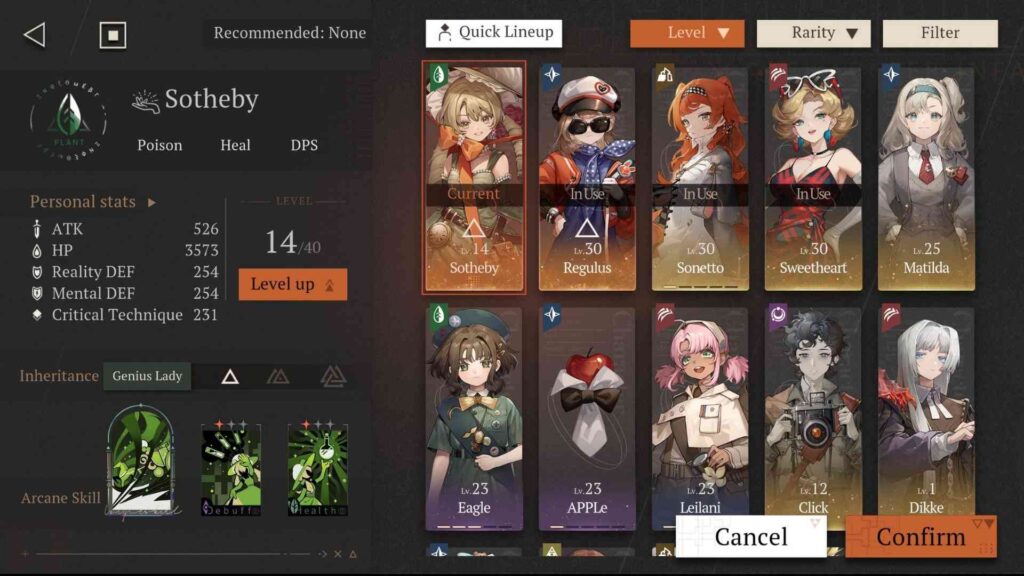
As you progress, you will need to farm Dust and Sharpodonty to unlock Insights, which raise your level caps:
- Insight I takes you to level 30
- Insight II raises it to 40
- Insight III goes up to 50 and unlocks passive abilities
You should also build up Resonance for extra stats. For your DPS characters, focus on ATK% since more attacks directly improve your damage.
Finally, do not forget about Psychubes, which act like special equipment that boosts your skills. For example, Brave New World is a great pick because it helps you generate more AP, letting you play more cards and keep the action flowing.
Best Reverse 1999 Team Compositions
Once you are comfortable with the basics, you can start building around meta teams. Each setup has its own strengths, synergies, and ideal game modes.
So, here are some of the best Reverse 1999 team building setups that you can rely on for the most reliable comps right now.
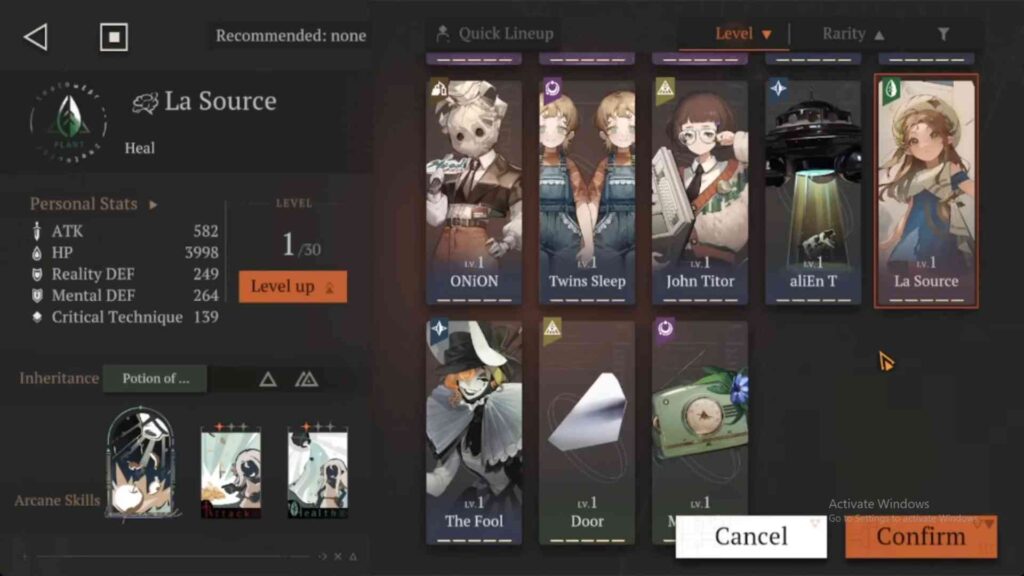
Crit Team: Lilya (DPS) + Regulus (Support) + An-An Lee (Support) + Tooth Fairy (Sustain)
This team is all about burst damage through crits. Lilya serves as your main DPS, and her skills and ultimate hit are much harder when they are critical. Regulus boosts crit rate while also giving you more turns with her AP generation at E1. An-An Lee adds another layer of support by increasing ATK and crit damage for the whole team. Tooth Fairy rounds it out with healing, cleansing, and a debuff that lowers enemy crit defense, letting your crits land even harder.
Regulus keeps Lilya’s skills flowing by feeding AP, while Tooth Fairy’s debuff pairs perfectly with An-An Lee’s buffs to push crit damage even higher. Since the whole team leans on the Star/Mental type, they are especially effective in stages where you face Mineral enemies, like Limbo or raid bosses.
Strengths
- Incredible burst potential for content that demands quick clears
- Shines in DPS check fights like UTTU and tough bosses
- Built-in healing and cleansing to counter poison or DoT-heavy stages
Weaknesses
- Damage relies heavily on crit RNG
- Struggles against enemies with strong Mental defenses or without an affinity edge
- Tooth Fairy’s healing, while steady, may feel light in extremely punishing battles
Where to Use this Team: This team is at its best in UTTU, Limbo runs with Mineral enemies, and big story bosses. For gear, try Hopscotch on Lilya to push crit damage further and Luxurious Leisure on Regulus for AP efficiency.
Poison Team: Jessica (DPS) + Sotheby (Sustain/Support) + Druvis III (Sub-DPS) + Pickles (Support)
As a poison team, this one focuses on stacking poison damage over time (DoT) for steady Mental damage, which works best in long battles. Jessica is your main DPS, applying multiple poison stacks and scaling her burst through her ultimate. Sotheby keeps your team alive with healing and cleansing, while also giving poison-related buffs that make DoT ticks stronger. Druvis III adds crowd control with Petrify and boosts Mental damage, and Pickles rounds things out with team-wide buffs and enemy debuffs.
Jessica and Sotheby both share Plant affinity, which strengthens poison synergy. Druvis III’s Petrify keeps enemies locked down long enough for poison ticks to pile up, while Pickles boosts Jessica’s scaling for even higher poison damage. Since the whole team deals with mental damage, they are especially effective in star-heavy stages.
Strengths
- Excellent in long fights like raids or Mane’s Bulletin, where poison damage keeps scaling
- Consistent damage even against mixed-affinity enemies
- Sotheby’s healing provides strong support for endurance battles
Weaknesses
- Slow to start, since poison needs time to build up
- Weak in short fights with tight DPS checks
- Struggles against poison-immune enemies or high Mental defense without Plant advantage
Where to Use this Team: This team shines in raids, Mane’s Bulletin, and story stages with Star enemies. For gear, try The Footloose on Jessica for stronger DoT and Her Second Life on Sotheby for better healing.
AP Manipulation Team: Charon (DPS) + Voyager (Support) + Medicine Pocket (Sustain) + Regulus (Sub-DPS)
The focus here is on AP efficiency, letting you spam skills and deal bursty Mental damage. Charon drives the team with his dynamo mechanic, generating AP and hitting hard with both skills and ultimate. Voyager keeps control of the fight with stuns, silences, and AP cost reductions. Medicine Pocket provides healing, shielding, and enemy damage debuffs. Regulus adds crit buffs and, at E1, extra turns through impromptu AP boosts.
Charon’s AP generation combines perfectly with Voyager’s cost reductions, giving you frequent high-star skill merges. Regulus adds even more AP acceleration, ensuring smooth rotations. Meanwhile, Medicine Pocket increases survivability with debuffs and sustain, making the team balanced for offense and defense. The mixed affinities—Spirit, Star, and Intellect—give you flexibility across content.
Strengths
- Extremely fast-paced with frequent skill use
- Great for DPS check content like UTTU or Limbo
- Voyager’s control abilities can shut down dangerous enemy ultimates
- Medicine Pocket’s sustain makes it reliable even in harder fights
Weaknesses
- Charon depends heavily on AP; if he gets stunned or debuffed, the team slows down
- Mixed affinities mean you lose the edge of a single-type advantage
- Requires careful AP management to fully optimize damage output
Where to Use this Team: This comp works best in UTTU, Limbo runs, and story bosses vulnerable to control effects. For equipment, use Thunderous Salute on Charon for more damage and Beyond Wonderland on Voyager to improve control.
Reality Burst Team: Reality Burst Team: Centurion (DPS) + Tennant (Support) + Bkornblume (Sub-DPS) + Vila (Sustain)
This lineup focuses on Reality damage bursts powered by moxie generation. Centurion leads as the main DPS, using rapid moxie gain to unleash a devastating ultimate. Tennant strengthens him with crit buffs and protective shields. Bkornblume applies Mental and Reality defense debuffs to open enemies up for massive hits, while Vila brings both Reality damage and reliable healing (especially strong at E1).
Centurion’s frequent moxie gain lines up perfectly with Tennant’s crit buffs for ultimate spamming. Bkornblume’s debuffs multiply the output of both Centurion and Vila, and Vila’s healing keeps the team alive through heavy damage phases. Their shared Beast/Plant traits make them especially effective against Star and Plant enemies.
Strengths
- This team thrives in burst-heavy fights such as raids and boss encounters.
- Centurion’s rapid moxie scaling ensures frequent nukes, while Vila sustains the team under pressure.
- Bkornblume’s versatile debuffs help them perform well against mixed defenses.
Weaknesses
- They can struggle against Mineral enemies, where affinity is less favorable.
- The team relies heavily on ultimate timing, leaving them vulnerable to enemy control effects.
- Tennant’s shielding also loses value against DoT-heavy encounters.
Where to Use this Team: Excellent for raids, story bosses, and stages stacked with Star or Plant foes. Equip Her Bright Future (Centurion) for faster moxie cycling or Blasphemer of Night (Bkornblume) for debuff extension.
Note: Most of the team members recommended in these setups can be summoned and upgraded with coins. To increase their potential, make sure to upgrade them constantly, and the cheapest way to do so is Enjoygm. You can buy top-up packs there for Reverse 1999 at a more affordable price than in the in-game store. The safest and most affordable way to top up your gameplay is Enjoygm.
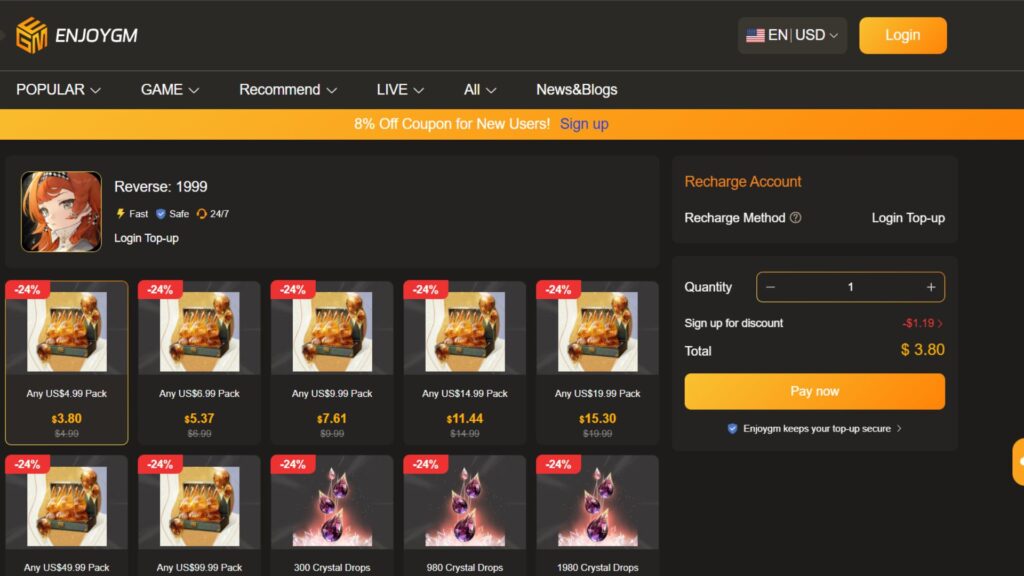
Conclusion
That is how you do a Reverse 1999 team building. Not every lineup suits every game mode, so make sure to thrive in the right setup as we described here. That alone will make you win quickly with more success.